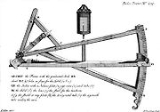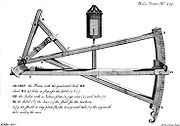
Elton's quadrant
Encyclopedia
An Elton's quadrant is a derivative of the Davis quadrant. It adds an index arm and artificial horizon to the instrument. It was invented by John Elton a sea captain who patented
his design in 1728 and published details of the instrument in the Philosophical Transactions of the Royal Society in 1732.
 This instrument clearly reflects the shape and features of the Davis quadrant. The significant differences are the change in the upper arc to a simple triangular frame and the addition of an index arm. The triangular frame at the top spans 60° as did the arc on the backstaff. The main graduated
This instrument clearly reflects the shape and features of the Davis quadrant. The significant differences are the change in the upper arc to a simple triangular frame and the addition of an index arm. The triangular frame at the top spans 60° as did the arc on the backstaff. The main graduated
arc subtends 30° as in the backstaff. The 30° arc is graduated in degrees and sixths of a degree, that is, at ten minute intervals.
The sighting vane of the backstaff is replaced with a sight (called an eye vane) mounted on the end of the index arm.
The index arm includes a nonius
to allow reading the large scale with ten divisions between the graduations on the scale. This provides the navigator with the ability to read the scale to the nearest minute of arc. The index arm has a spirit level
to allow the navigator to ensure that the index is horizontal even when he cannot see the horizon.
The instrument has a horizon vane like a Davis quadrant, but Elton refers to it as the shield or ray vane. The shield is attached to the label. The label is an arm that extends from the centre of the arc to the outside of the upper triangle and can be set to one of the three positions in the triangle (in the diagram, it appears to bisect the triangle as it is set to the centre or 30° position). At the upper end of the label is a Flamsteed glass or lens.
The three set positions allow the instrument to read 0° to 30°, 30° to 60° or 60° to 90°. The lens projects an image of the sun rather than a shadow of the sun on the shield. This provides an image even when the sky is hazy or lightly overcast. In addition, at the mid-span of the label there is a mounting point for a lantern to be used during nocturnal observations.
There are two spirit levels on the shield. One, called the azimuth tube, ensures that the plane of the instrument is vertical. The other is perpendicular
to the shield and will indicate when the plane of the shield is vertical and the label is horizontal.
Hold the instrument in a comfortable manner with the arc towards the sun. Set the label so that the sun's image is projected on the shield at the hole with the index arm roughly horizontal. Move the index arm so that the index's spirit level shows the arm is precisely horizontal. This sets the instrument and the angle can be read with the scale and nonius.
Set the label to a position that will put the object to be measured within the range of the instrument. Observe the object through the eye vane so that the object touches the upper edge of the shield while using the azimuth tube to ensure that the frame is vertical. Move the index arm so that the shield's horizontal tube indicates that the shield is precisely vertical. This sets the instrument and the angle can be read on the arc.
published details on his octant
prior to Elton's article in the same volume of the Philosophical Transactions (article 37 vs 48).
Given that Elton's quadrant was roughly as complex as an octant in construction, there would not likely be a significant advantage in price. The octant was an easier instrument to use and Hadley had supported the use of artificial horizon's on the octant in the form of spirit levels. This would have given no advantage to Elton's instrument. In addition, there were many other instruments competing for the attention of navigators in this period. In the end, the Hadley octant and later sextant
took precedence as instruments for navigators.
his design in 1728 and published details of the instrument in the Philosophical Transactions of the Royal Society in 1732.
Construction

Graduation (instrument)
-Linear graduation:Linear graduation of a scale occurs on a straight instrument. The graduation can identify linear measures, such as inches or millimetres on a rule. They can also be non-linear such as logarithmic or other transcendental scales....
arc subtends 30° as in the backstaff. The 30° arc is graduated in degrees and sixths of a degree, that is, at ten minute intervals.
The sighting vane of the backstaff is replaced with a sight (called an eye vane) mounted on the end of the index arm.
The index arm includes a nonius
Nonius
Nonius can refer to:Persons* Pedro Nunes , Portuguese astronomer and mathematician.* Nonius Marcellus, Latin grammarian and lexicographer, lived at the end of the 3rd or the beginning of the 4th century AD....
to allow reading the large scale with ten divisions between the graduations on the scale. This provides the navigator with the ability to read the scale to the nearest minute of arc. The index arm has a spirit level
Spirit level
A spirit level or bubble level is an instrument designed to indicate whether a surface ishorizontal or vertical . Different types of spirit levels may be used by carpenters, stonemasons, bricklayers, other building trades workers, surveyors, millwrights and other metalworkers, and in some...
to allow the navigator to ensure that the index is horizontal even when he cannot see the horizon.
The instrument has a horizon vane like a Davis quadrant, but Elton refers to it as the shield or ray vane. The shield is attached to the label. The label is an arm that extends from the centre of the arc to the outside of the upper triangle and can be set to one of the three positions in the triangle (in the diagram, it appears to bisect the triangle as it is set to the centre or 30° position). At the upper end of the label is a Flamsteed glass or lens.
The three set positions allow the instrument to read 0° to 30°, 30° to 60° or 60° to 90°. The lens projects an image of the sun rather than a shadow of the sun on the shield. This provides an image even when the sky is hazy or lightly overcast. In addition, at the mid-span of the label there is a mounting point for a lantern to be used during nocturnal observations.
There are two spirit levels on the shield. One, called the azimuth tube, ensures that the plane of the instrument is vertical. The other is perpendicular
Perpendicular
In geometry, two lines or planes are considered perpendicular to each other if they form congruent adjacent angles . The term may be used as a noun or adjective...
to the shield and will indicate when the plane of the shield is vertical and the label is horizontal.
Solar altitude by backsight
For measuring the altitude of the sun, the Elton's quadrant can be used in the same manner as a Davis quadrant. However, with the artificial horizon, the eye vane is not required to be used.Hold the instrument in a comfortable manner with the arc towards the sun. Set the label so that the sun's image is projected on the shield at the hole with the index arm roughly horizontal. Move the index arm so that the index's spirit level shows the arm is precisely horizontal. This sets the instrument and the angle can be read with the scale and nonius.
Stellar altitude by foresight
This is a means of measuring altitude of a celestial object that is very different from what can be done with a Davis quadrant. It reveals one of the significant improvements of the Elton's quadrant over the former instrument.Set the label to a position that will put the object to be measured within the range of the instrument. Observe the object through the eye vane so that the object touches the upper edge of the shield while using the azimuth tube to ensure that the frame is vertical. Move the index arm so that the shield's horizontal tube indicates that the shield is precisely vertical. This sets the instrument and the angle can be read on the arc.
Significance to navigation
The Elton's quadrant is not very well known as a navigation instrument. It was used, though to what degree is not known. Elton had the misfortune to invent his instrument in the same period of time as the octant. In fact, John HadleyJohn Hadley
John Hadley was an English mathematician, inventor of the octant, a precursor to the sextant, around 1730.He was born in Bloomsbury, London, to Katherine FitzJames and George Hadley....
published details on his octant
Octant (instrument)
The octant, also called reflecting quadrant, is a measuring instrument used primarily in navigation. It is a type of reflecting instrument.-Etymology:...
prior to Elton's article in the same volume of the Philosophical Transactions (article 37 vs 48).
Given that Elton's quadrant was roughly as complex as an octant in construction, there would not likely be a significant advantage in price. The octant was an easier instrument to use and Hadley had supported the use of artificial horizon's on the octant in the form of spirit levels. This would have given no advantage to Elton's instrument. In addition, there were many other instruments competing for the attention of navigators in this period. In the end, the Hadley octant and later sextant
Sextant
A sextant is an instrument used to measure the angle between any two visible objects. Its primary use is to determine the angle between a celestial object and the horizon which is known as the altitude. Making this measurement is known as sighting the object, shooting the object, or taking a sight...
took precedence as instruments for navigators.
External links
- Maritime Art Greenwich, at the National Maritime Museum, London Painting of a captain holding an Elton's Quadrant.

